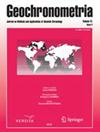Dendrochronological dating of St. George’s Orthodox Church in Drohobych, Ukraine
IF 0.9
4区 地球科学
Q3 Earth and Planetary Sciences
引用次数: 1
Abstract
Abstract St. George’s Orthodox Church in Drohobych is a wooden monument of sacral architecture, recently registered in the UNESCO World Heritage List. However, clear, unequivocal written sources about the origins of the structure are lacking. Absolute dating was attempted with the dendrochronological method, and it was carried out in a noninvasive way due to the status and value of the object. Construction elements of the church were documented with over 40 macrophotographs. The studies were made for selected elements, displaying distinct perpendicular or tangential cross sections. Most of the elements examined represented fir wood. It turned out that the wood used for the construction of this church was contemporaneous and most likely represented a single construction phase. The 124-year chronology based on correlated curves covers the period 1464–1598 AD. Construction elements with the outermost rings retained indicate that the timber was harvested in the 1590s. In most cases, the outermost rings were lacking, which allowed only for dating terminus post quem. The youngest preserved rings (1598 AD) from the church wood apparently reveal the dates of both the wood harvesting and the structure’s construction. Such a dating may indicate that the church mentioned in the sources as purchased in Nadiyevo in 1657 AD could be the basis for the rebuilding of Drohobych St. George’s Orthodox Church, only adapted to the new conditions. The church later underwent renovation, consisting in reconstruction of the dome in 1821 AD.乌克兰德罗霍比奇圣乔治东正教教堂的年代学
摘要Drohobich的圣乔治东正教堂是一座骶骨建筑的木制纪念碑,最近被联合国教科文组织列入世界遗产名录。然而,缺乏关于该结构起源的明确、明确的书面资料。绝对年代测定是用树状年代测定法进行的,由于对象的地位和价值,它是以一种非侵入性的方式进行的。教堂的建筑元素被记录在40多张宏观照片中。这些研究是针对选定的元素进行的,显示了不同的垂直或切向横截面。所检查的大多数元素都代表杉木。事实证明,用于建造这座教堂的木材是同时代的,很可能代表了一个单一的建造阶段。基于相关曲线的124年年表涵盖了公元1464年至1598年。保留最外圈的建筑元素表明木材是在1590年代收获的。在大多数情况下,最外层的环都是缺失的,这只允许在quem后进行定年。教堂木材中保存最年轻的戒指(公元1598年)显然揭示了木材采集和建筑的日期。这样的年代测定可能表明,资料中提到的公元1657年在纳迪耶沃购买的教堂可能是重建Drohobich圣乔治东正教会的基础,只是适应了新的条件。教堂后来进行了翻修,包括在公元1821年重建圆顶。
本文章由计算机程序翻译,如有差异,请以英文原文为准。
求助全文
约1分钟内获得全文
求助全文
来源期刊

Geochronometria
地学-地球科学综合
CiteScore
2.20
自引率
0.00%
发文量
1
审稿时长
>12 weeks
期刊介绍:
Geochronometria is aimed at integrating scientists developing different methods of absolute chronology and using them in different fields of earth and other natural sciences and archaeology. The methods in use are e.g. radiocarbon, stable isotopes, isotopes of natural decay series, optically stimulated luminescence, thermoluminescence, EPR/ESR, dendrochronology, varve chronology. The journal publishes papers that are devoted to developing the dating methods as well as studies concentrating on their applications in geology, palaeoclimatology, palaeobiology, palaeohydrology, geocgraphy and archaeology etc.
 求助内容:
求助内容: 应助结果提醒方式:
应助结果提醒方式:


